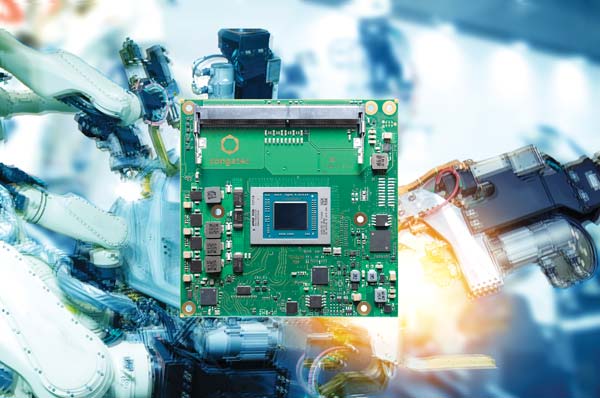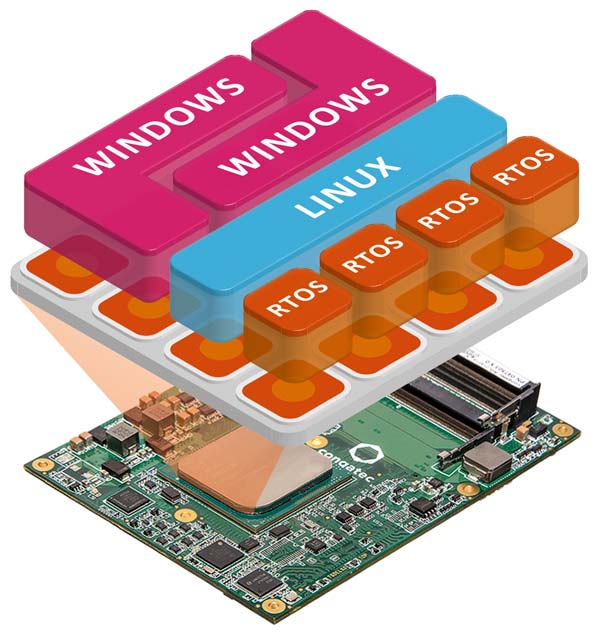
Figure 1: With up to 8 cores, AMD Ryzen Embedded V2000 based Computer-on-Modules can process many tasks in parallel. — © Ekkasit919 / Dreamstime.com / congatec
In the past, there was rarely a need to put much emphasis on a high number of cores as most established embedded systems had little parallel processing to do. With Industry 4.0 and IIoT digitization, this picture has dramatically changed. IoT gateways and edge computers can hardly get enough cores. Thanks to AMD Ryzen™ Embedded V2000 processor technology and RTS hypervisor support, congatec’s new COM Express Type 6 modules are perfect for these IoT gateway application needs.
Previously, classic x86 embedded systems used to consolidate at the very most control and HMI in one system – if there was any task consolidation at all. Today, Industry 4.0 and IIoT digitization demand many additional gateway and edge computing tasks, to read and analyze all the data, transcode logs, send alerts, and so on. Access to multiple instances also needs managing – from devices and users to administrators, both on behalf of the customer and the OEM. Locally as well as remotely. With VPN, encryption, firewall, whitelisting, intrusion detection and other security features. And last but not least, OPC-UA communication must be managed – in real time and with TSN support.
Control and IoT gateway in one system

Figure 2: To consolidate multiple edge applications in one system, congatec’s Server-on-Modules support real-time hypervisor technology from Real-Time Systems. (© congatec)
Nowadays, existing machines and systems are often retrofitted with these and many other new functions using external gateway systems. In new OEM designs to be embedded into machines and systems, control and GUI tend to get integrated directly. In the interest of hardware consolidation, such new solutions allow the integration of all the various functions in one system. Sometimes, even several production cell controls are condensed in a single system. The controls still communicate via Ethernet, but often it’s a matter of one virtual machine talking to another. Only the sensors and vision systems as well as the actuators/drives of the manufacturing robots are then distributed in the production cell itself. Communication is increasingly taking place over real-time IP, often using simple single-pair Ethernet cabling via 10BASE-T1S or 10BASE-T1L. The choice between S or L then boils down to whether the system must communicate across no more than 25 meters in discrete manufacturing, or up to 1000 meters in the process industries. However, implementations increasingly include over IP functionality and thanks to TSN support also cater for deterministic real time.
Less than 1 watt TDP per core is possible
Will such high integration necessitate the installation of air-conditioned server rooms in production cells? Fortunately, not! First, because new COM-HPC server modules that provide rugged edge servers with entry-level data center performance will soon be available. And second, because the number of cores in client systems has also increased from the standard 2 to 4, to up to 8. Importantly, these systems still don’t require fan cooling. The current flagship processor for such systems is the new AMD Ryzen™ Embedded V2000 processor, which features up to 8 cores and supports up to 16 threads. congatec offers it on space-saving COM Express Compact Type 6 Computer-on-Modules. With twice the performance of the earlier AMD Ryzen™ Embedded V1000 processors, the modules set a new performance-per-watt benchmark that according to AMD tests yields the highest performance gains in 15‑watt TDP designs. If the TDP of the AMD Ryzen™ Embedded V2718 is throttled down to 10 watt, solutions that consume as little as 1.25 watt TDP per x86 core are possible, not factoring in other features such as graphics cores. The outstanding performance leap of this low-power platform was validated with the Cinebench R15 nt cross-platform test suite simulating real-world application scenarios. Compared to modules with AMD Ryzen™ Embedded V1608B processors, conga-TCV2 modules deliver 97% (V2516) to 140% (V2718) more performance on up to 8 cores. Thanks to the new 7nm Zen 2 cores, single-core performance is also up by 25% to 35%. This makes the new modules a perfect fit for the diverse tasks of 24/7-connected fanless embedded systems deployed across a wide range of industrial edges. Multifunctional industrial edge gateways are therefore a major application area. With up to 40% more GPU performance for up to 4x 4k60 graphics and full GPGPU support, machine vision and machine learning systems are further target markets.
Fanless and passively cooled systems
The new AMD Ryzen Embedded V2000 processor is of course also a great choice for actively cooled systems with 54 watt TDP. However, it is not uncommon for customers to require fanless and passively cooled systems with 15 watt TDP or even less. The goal of such strict power limitations is to enable extremely rugged, fully enclosed systems for reliable 24/7 operation in harsh environments. For such applications, the performance per watt gains delivered by the new AMD Ryzen Embedded V2000 processors are ideal. And since these gains are closely linked to the higher number of cores, V2000 processors are predestined for use as multitasking platforms at the edge.

Figure 3: AMD Ryzen Embedded V2000 processors vs. 9th and 10th generation Intel Core i7 processors. Since the performance advantage is distributed over 8 cores, the new processors are literally predestined for multitasking at the edge. — (© AMD)
Hypervisors are essential for multitasking
But how do you integrate all these different tasks – especially when control design must be deterministic and TSN-supported real-time communication via Ethernet is required? In embedded systems that need real time – which many industrial applications in Industry 4.0 environments do – it is no longer possible to simply place a container above the operating system to effectively encapsulate the individual tasks. Instead, real-time control requires full and exclusive hardware access. Real-time multitasking therefore needs real-time capable hypervisor technology as offered by Real-Time Systems. All x86 Computer-on-Modules from congatec support hypervisor technology by default, and the company also takes care of customer implementation in collaboration with developers from Real-Time Systems. All in all, this makes it theoretically possible to integrate a dedicated control on each of the new Computer-on-Module’s 8 cores and to operate these controls independently, so when one needs rebooting, this does not affect the real-time capability of the other virtual machines.
Flexible system design for every application

Figure 4: The new high-performance conga-TCV2 COM Express Compact modules with Type 6 pinout are based on the latest AMD Ryzen Embedded V2000 multicore processors and come in 4 different variants. — (© congatec)
In practice, there will be system installations hosting one or more real-time controls in separate virtual machines of the RTS hypervisor to allow deterministic control of each robot in a production cell. For all other tasks, one or more additional virtual machines can be opened, and container virtualization implemented above their OS. This can be done using Docker, an open-source software for isolating applications wherever real-time is not required. Such a solution is extremely convenient, as the containers en bloc contain all the data required to deploy the application. As a result, these data files are also easier to install and transport, which ultimately simplifies resource management. When flexible resource allocation with RTS real-time hypervisor technology and Docker container virtualization are coupled with the resource scaling opportunities a demands-based choice of suitable modules provides, it becomes easy to create perfectly tailored edge computers and IoT gateways, and to adapt to constantly changing demands. As the TDP is configurable, developers can also scale it to match the exact system requirements. Available in two 6- and 8-core variants, the new AMD Ryzen Embedded processors currently rank top of the embedded client class with a TPD that is scalable from 10 to 54 watt across the family.
The new conga-TCV2 Computer-on-Modules with AMD Ryzen Embedded V2000 processors offer 6 to 8 cores and feature 4MB L2 cache, 8MB L3 cache and up to 32GB energy-efficient and fast dual-channel 64-bit DDR4 memory with up to 3200 MT/s and ECC support for maximum data security. The integrated AMD Radeon™ graphics with up to 7 processing units can be used as GPGPU. However, it also supports up to four independent displays with up to 4k60 UHD resolution over 3x DisplayPort 1.4/HDMI 2.1 and 1x LVDS/eDP, making it an extremely powerful GUI for machines and systems as well as control station and control room computers. Other performance-oriented interfaces include 1x PEG 3.0 x8 and 8x PCIe Gen 3 lanes, 4x USB 3.1, 8x USB 2.0, up to 2x SATA Gen 3, 1x Gbit Ethernet, 8 GPIO I/Os, SPI, LPC, and 2x legacy UART provided by the board controller. The modules support the RTS Hypervisor as well as the Microsoft Windows 10, Linux/Yocto, Android Q, and Wind River VxWorks operating systems. The integrated AMD Secure processor helps with hardware-accelerated RSA, SHA and AES encryption and decryption, which is important for safety-critical applications. TPM support is also provided onboard. More information about the new high-performance conga-TCV2 COM Express Compact Type 6 module is available at: https://www.congatec.com/en/products/com-express-type-6/conga-tcv2/

Author: Andreas Bergbauer,
Senior Product Line Manager, congatec AG
| Processor | Cores/ Threads |
Clock rate [GHz] (base/boost) | L2/L3 Cache (MB) |
GPU Compute Units | TDP [W] | |||||
| AMD Ryzen™ Embedded V2748 | 8 / 16 | 2.9 / 4.25 | 4 / 8 | 7 | 35 – 54 | |||||
| AMD Ryzen™ Embedded V2718 | 8 / 16 | 1.7 / 4.15 | 4 / 8 | 7 | 10 – 25 | |||||
| AMD Ryzen™ Embedded V2546 | 6 / 12 | 3.0 / 3.95 | 3 / 6 | 6 | 35 – 54 | |||||
| AMD Ryzen™ Embedded V2516 | 6 / 12 | 2.1 / 3.95 | 3 / 6 | 6 | 10 – 25 |



